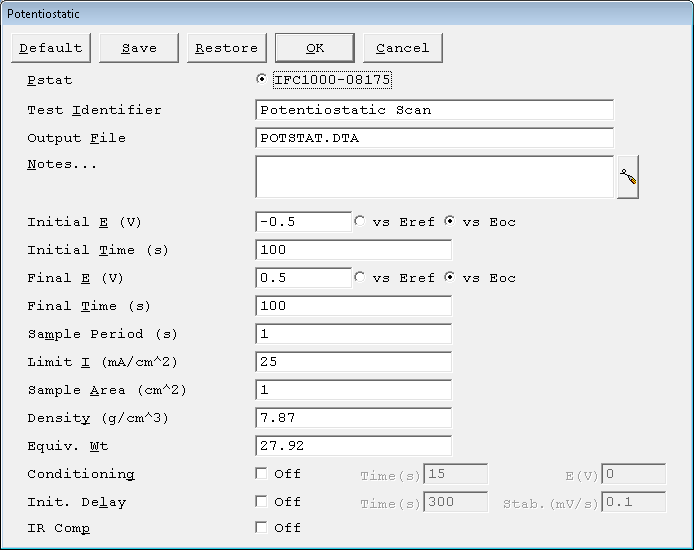Potentiostatic Setup Parameters
Here is a Potentiostatic Setup dialog box complete with its default parameters.

Initial E
- The potential prior to any potential step. The allowed range is ±10 V with a resolution of 1/8 mV. Its accuracy depends on the setting.
Initial Time
- The time period that the potential is at the Initial E. You can also think of the Initial Time as the length of time in which data is acquired before the voltage step. The units of the Initial Time are seconds. The resolution is set by the Sample Period parameter discussed below.
Final E
- The potential after the potential step. The allowed range is ±10 V with a resolution of 1/8 mV. Its accuracy depends on the setting.
Final Time
- The time period that the potential is at the Final E. You can also think of the Final Time as the length of time in which data are acquired after the voltage step. If no step is desired, enter a Final Time of zero. The units of the Final Time are seconds. The resolution is set by the Sample Period parameter discussed below.
Sample Period
- The spacing between data points. The units used for the Sample Period are seconds. The shortest Sample Period we recommend is 0.25 second. The longest Sample Period allowed is 600 seconds.The Sample Period also helps determine the Number of Points in the data curve as follows:
Number of Points = (Initial Time + Final Time) / Sample Period
The Number of Points must be less than 262 143. If you have more points, the experiment will abort just before the scan phase of the sequence.The resolution in the Initial Time and Final Time is also controlled by the Sample Period. Times that are not integer multiples of the Sample Period are rounded down. For example, if the Sample Period is set for 8 seconds, and an Initial Time of 50 seconds is requested, the actual Initial Time is 48 seconds, which is 6 Sample Periods.
Limit I
- Prevents excessive cell current. If the absolute value of the current exceeds the Limit I, acquisition of data in the current step stops early. Exceeding the Limit I at the Initial E causes the potential to be stepped, and at the Final E causes the experiment to terminate.

Comments are closed.